- Geosynclines are the area of long, wide, and shallow depression of the water body bordered by rigid masses and get huge sedimentation deposition from surrounding areas.
- The term is used for such long and relatively narrow ocean basins in which deposition of sediments has
continued for a long time and which during the period of deposition has suffered subsidence. - It is these sediments that have been uplifted and folded to form folded mountain ranges. It is therefore said that the mountains have been formed out of geosynclines.
- The Tethys Sea in Asia, the Appalachian geosynclines in N. America, and the Caledonian geosynclines in Great Britain provide examples of geosynclines in geological times.
Concept of Geosyncline theory and its Development
- The concept of geosynclines was forwarded by Hall and Dana and elaborated by Haug.
- Based upon his research on the stratigraphy and structure of the northern Appalachians, James Hall discovered that the folded Palaeozoic sediments belonging to mountain ranges are the shallow-water types of marine origin having a thickness of 12 km.
- James Hall also found that the thickness was ten to twenty times greater in comparison to the unfolded rock strata of corresponding ages found in the interior lowlands towards the west.
- The deposition of the massive sequence of shale, sandstone, and limestone suggests that the underlying floor of older rocks subsided by a similar amount.
- The mountain formation was preceded by prolonged periods of down-warping during which the process of sediment accumulation maintained a balance with the subsidence of the crust.
- Dana (1873) called such trough geosynclinals trough and subsequently, they came to be known by the name of ‘geosynclines’.
- H. Stille presented a significant classification of geosynclines. He divided the earth’s crust into two major divisions called Cratons and Ortho-geosyncline.
- Cratons are further sub-divided into hochkraton (i.e. stable continental crust) and fiefkraton (i.e. stable oceanic crust).
- Ortho-geosyncline are also subdivided into miogeosynclines and eugeosynclines. Eugeosynclines are characterized by intermittent volcanic activity during the process of sedimentation, whereas miogeosynclines have low volcanic activity.
- The two classes are found side by side separated by a geanticline in the middle. Miogeosynclines are now considered to be former continental margins like those fringing the Atlantic Ocean and eugeosynclines represent the inverted and deformed equivalents of ocean basins of smaller magnitude such as the marginal basins of the western part of the Pacific, the Sea of Japan, and the Sea of Okhotsk.
- E. Haug defined geosynclines as deepwater regions of considerable length but relatively narrow in width. Haug drew palaeogeographical maps of the world to prove that the present-day fold mountains originated from massive geosynclines of the past.
- Haug postulated five major landmasses belonging to the Mesozoic Era, namely (i) North Atlantic Mass (ii) Sino-Siberian Mass (iii) Africa- Brazil Mass (iv) Australia-India Madagascar Mass, and (v) Pacific Mass.
- He identified four geosynclines located between these rigid masses: (i) Rockies geosyncline (ii) Ural geosyncline (iii) Tethys geosyncline and (iv) Circum-Pacific geosyncline.
- According to Haug, the transgressional and regressional phases of seas have a direct impact on the littoral margins of the geosynclines.
- According to Evans,
- geosynclines may be placed between two landmasses, e.g., Tethys geosyncline between Laurasia and Gondwanaland;
- geosynclines may be found in front of a mountain or a plateau, for example, after the origin of the Himalayas there was a long trench in front of the Himalayas which was later filled with sediments leading to the formation of the vast Indo-Gangetic plains;
- geosynclines are found along the continental margins;
- geosynclines may exist in front of a river mouth.
Geosynclinal Orogen Theory of Kober
- Famous German geologist Kober has presented a detailed and systematic description of the surface features of the earth in his book ‘Der Bau der Erde’. His main objective was to establish a relationship between ancient rigid masses or tablelands and more mobile zones or geosynclines, which he called orogen.
- Kober not only attempted to explain the origin of the mountains on the basis of his geosynclinal theory but he also attempted to elaborate the various aspects of mountain building e.g., formation of mountains, their geological history, and evolution, and development.
- He considered the old rigid masses as the foundation stones of the present continents. According to him present continents have grown out of rigid massess. He defined the process of mountain building or orogenesis as that process which links rigid masse with geosynclines. In other words, mountains are formed from the geosynclines due to the impacts of rigid masses.
- Kober’s geosynclinal theory is based on the forces of contraction produced by the cooling of the earth. He believes in the contraction history of the earth.
- According to J.A. Steers (1932) “Kober is definitely a constructionist, contraction providing the motive force for the compressive stress”.
- In other words, the force of contraction generated due to the cooling of the earth causes horizontal movements of the rigid masses or forelands which squeeze, buckle and fold the sediments into mountain ranges.
Base of the Geosynclinal Orogen Theory:
- According to Kober there were mobile zones of water in the places of present-day mountains. He called mobile zones of water as geosynclines or orogen (the place of mountain building). These mobile zones of geosynclines were surrounded by rigid masses which were termed by Kober as kratogen.
- The old rigid masses included Canadian Shield, Baltic Shield or Russian Massif, Siberian Shield, Chinese Massif, Peninsular India, African Shield, Brazilian Mass, Australian and Antarctic rigid masses. According to Kober mid-Pacific geosyncline separated north and south forelands which were later on foundered to form Pacific Ocean.
- Eight morphotectonic units can be identified on the basis of the description of the surface features of the earth during Mesozoic era as presented by Kober e.g.:
- (i) Africa together with some parts of Atlantic and Indian Oceans,
- (ii) Indian Australian land mass,
- (iii) Eurasia,
- (iv) North Pacific continents,
- (v) South Pacific continents, and
- (vi) South America and Antarctica etc.
- Kober has identified 6 major periods of mountain building.
- Three mountain building periods, about which very little is known, are reported to have occurred during pre-Cambrian period.
- Palaeozoic era saw two major mountain building periods – the Caledonian orogenesis was completed by the end of Silurian period and the Variscan orogeny was culminated in Permo-Carboniferous period.
- The last (6th) orogenic activity known as Alpine orogeny was completed during Tertiary epoch.
- Kober has opined that mountains are formed out of geosynclines. According to Kober geosynclines, the places of mountain formation (known as orogen) are long and wide water areas characterized by sedimentation and subsidence.
- According to J.A. Steers (1932) ‘Kober’s views (on geosynclines and orogenesis) are, then, a combination of the old geosynclinal hypothesis of Hall and Dana, which was developed later by Haug, and his own views on orogenesis.
Phases of the Mountain Building
There are three different stages or phases of the mountain-building process.
Lithogenesis
- This stage is characterized by the creation, sedimentation, and subsidence of geosynclines.
- Geosynclines are formed due to contraction caused by the cooling process of the earth.
- The forelands or kratogens which border geosynclines succumbed to the forces of denudation. As a result, there was constantly wearing a way of rocks and boulders from the forelands and deposition of the eroded material on the beds of geosynclines. This led to the subsidence of geosynclines.
- The twin processes of sediment deposition and the resultant subsidence led to further sediment deposition and increasing thickness of sediments.
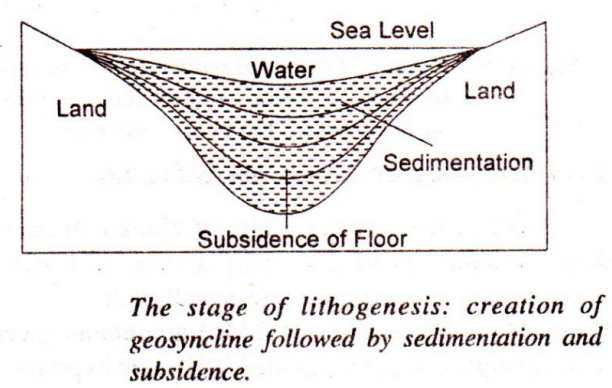
Orogenesis
- In this stage, the geosynclinal sediments are squeezed and folded into mountain ranges.
- There is a convergence of forelands towards each other due to the force of the contraction of the earth.
- The enormous compressive forces produced by these moving forelands produce contraction, squeezing, and folding of sediments deposited on the geosynclinal bed.
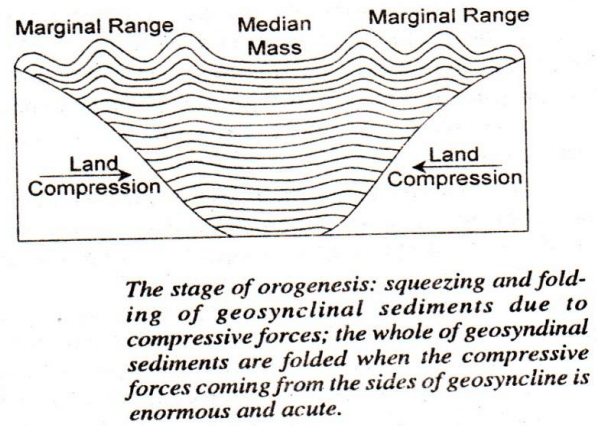
Gliptogenesis
- This phase of mountain building is characterized by a gradual ascent of mountain ranges and the ongoing denudation processes by natural agents.
- The three phases of mountain building may be also called three phases of the evolution of geosynclines.
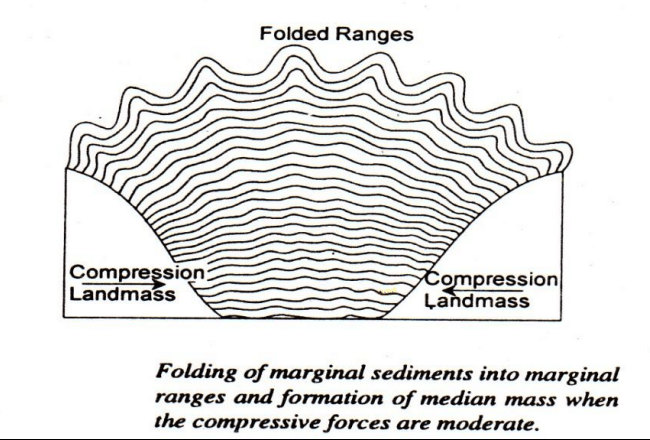
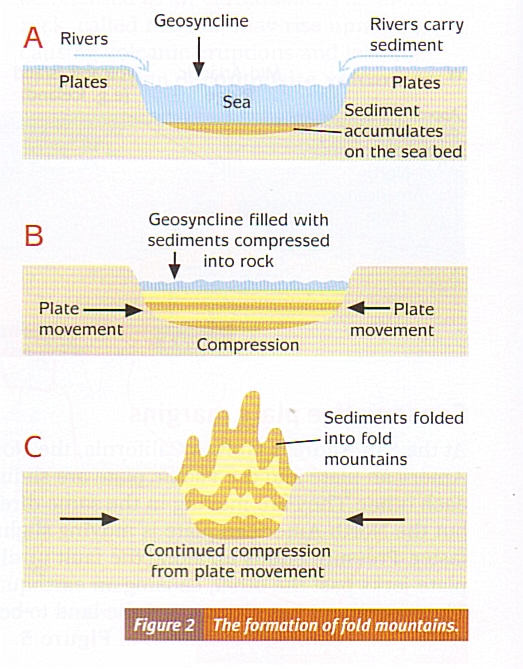
Types of geosynclines
There are seven types of geosynclines as follows:
- Ortho-geosynclines: These are elongated basins which become filled with very great thickness of sediments, which is subse-quently deformed to form a fold-mountain chain.
- Eugeosyncline: In these geosynclines, the piles of sedi-ments are found with an abundance of volcanic rocks; they are formed at some distance from the shield areas, i.e., Kratons.
- Miogeosyncline: These are formed adjacent to the Kraton, where there is a thinner development of sediments which lack volcanic rocks.
- Taphrogeosyncllne: This is an elongated depression, formed because of faulting. These are also known as ‘graben’ or ‘rift-valley’.
- Parageosyncline: This is the geosyncline which lies with-in the Kraton.
- Zeugo-geosyncline: These are parageosyncline with marginal uplifts.
- Auto-geosyncliie: It is a para-geosyncline without marginal uplifts.
Most orogenic-belts arise on the sites of geosynclines and the resulting mountains, therefore, consist of sediments and volcanic rocks deformed and metamorphosed to a greater or lesser extent according to their position and depth in the orogenic belt.
The Modern Concept of Geosyncline
- The ideas about geosynclines underwent a significant change with the introduction of the Plate Tectonic Theory. A continental margin placed along a plate margin is known for subduction, collision, or transform fault motion is called an active margin, while a continental margin that shifts away from a spreading axis is termed passive.
- For example, on the east coast of North America, a passive continental margin keeps depositing sediments with the gradual movement of the continent away from the spreading axis. The lithosphere becomes cooler and denser at an accelerated rate accompanied by an increasingly deeper ocean floor off the passive margin, as the sediments continue to get deposited on the ocean floor. Such a thick column of sediment along the border of a passive margin is called geosyncline.
- The studies conducted during the second phase of the 20th century reveal that a geosyncline is a thick, rapidly accumulating body that lies parallel to the continent. The age-old idea of a geosyncline or an intra-cratonic trough bordered by mountains contributing sediments needs to be abandoned. The accumulation of sediments may take place on the continental shelf and slope or in a trough or trench.
- Nowadays, the term ‘geocline’ is used because the structure of a geosyncline is not a two-sided trough; rather, it is more open towards the ocean.
- Geoclines of passive continental margins can be divided into two types:
- miogeoclines or the wedges of shallow-water sediments of marine origin which constitute the continental shelves; and
- eugeoclines or wedges of deep-sea sediment deposited at the foot of the continental slope and lying on oceanic crust.
- Both types of geoclines are made by sediments accumulated accompanied by slow subsidence of the lithosphere.
- In the Gulf of Mexico, the miogeocline sediments attain a thickness of 20 km at the external fringe of the continental shelf. Eugeocline sediments are found in the oceanic crust just above an oceanic volcano. The uninterrupted accumulation of sediments in the miogeoclines for about 200 million years has been possible due to the sinking of the crust as a result of sediment loading. The miogeocline areas bear great economic importance due to the availability of mineral oil.
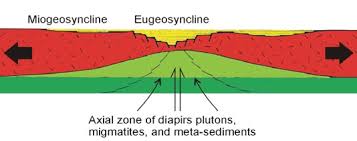
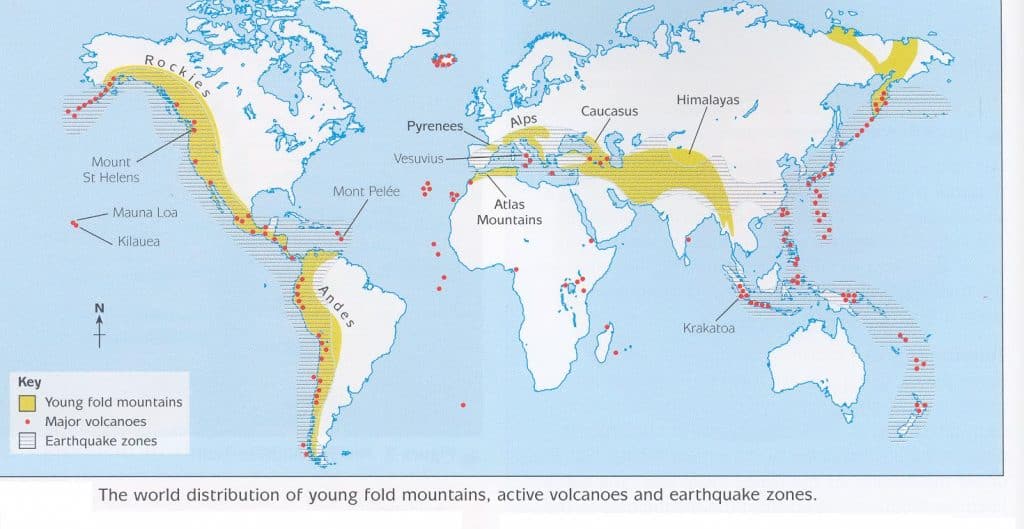

Its perfect Sir ji… Good 😚
Unbelievable notes thanks a lot
Best notes
Did india have volcano ..near Andhra Pradesh??
very well explained .
sir can you also add criticism of Kober’s theory
Sir aise hi notes provide karaye hamare liye help ho jati hai